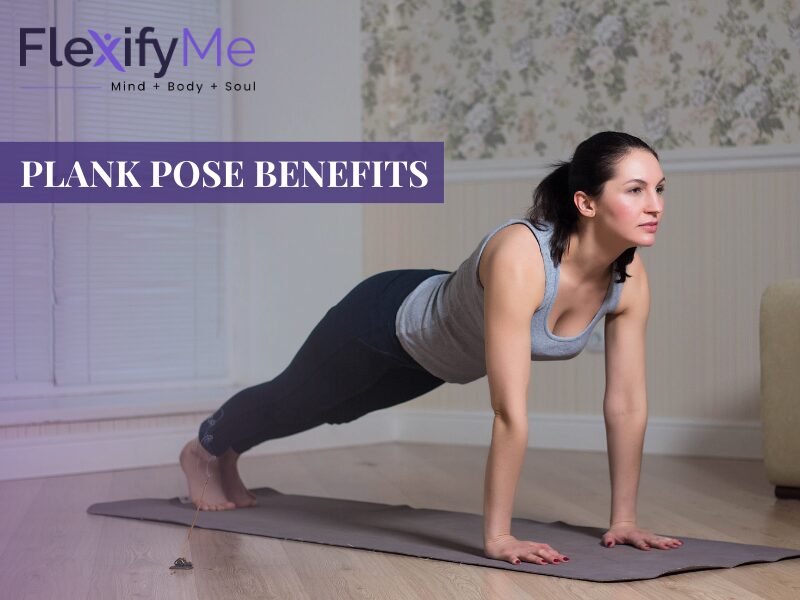Do you feel you need to strengthen your core muscles? Try plank pose or phalakasana. It is one of the simplest yet most effective positions to learn.
Though focused on core strength, the plank benefits the entire body as it engages the spine, abdomen, shoulder, and glutes. Although it may seem a little tricky in the beginning, one can master it with practice and consistency.
Regular plank practice fortifies your core strength, improves the posture and builds endurance. It is an excellent exercise and is suitable for all fitness levels, offering several benefits. Let us understand some of these benefits and how to do the plank pose.
Plank Pose Benefits You Should Know About

If done regularly, the plank pose can be extremely beneficial for your overall fitness. Here are some of the key benefits:
Strengthening of the core muscles: While doing the plank, one engages the pelvis, abdominal, and lower back muscles. These are some of the most important muscles in the body, so this exercise is of utmost importance for people looking to enhance their core strength.
Builds endurance: By increasing the time for which one holds the plank position, one can improve the strength and endurance of the body.
Improves stability: The person’s balance is also improved since the person has to hold the pose in a straight line. This also improves stability.
Boosts metabolism: Although it may appear to be a stationary position, holding the plank increases the heart rate like a cardio exercise. This, in turn, increases the metabolic rate and helps shed calories.
A word of caution for people having carpal tunnel syndrome or osteoporosis- they should avoid the plank pose or consult a doctor before attempting it. This is due to the risk of fractures.
How To Do The Plank Pose
Try this posture in a spot where you have ample space to stretch the body. Make sure to use a yoga mat to have a smooth comfortable surface.
- Begin in the plank position, face down with your forearms and toes on the floor.
- Your elbows should be under your shoulders and the forearms facing outward. The head should be relaxed.
- Engage your abdominal muscles, drawing in your belly.
- Keep your torso straight, firm and your body in a straight line from your ears to your toes, there should not be any bending.
- Be sure to keep the shoulders down.
- Hold this position for 10 seconds. Release to floor.
- You can gradually increase the holding time to 20,30 and then up to 50 seconds.
Important Tip for Beginners
- Be sure to engage the thigh muscles. You can also try holding a yoga brick between the thighs to engage the legs while doing this pose.
- If you are just starting new with this pose, build the time on your hands gradually. This will strengthen the wrist muscles.
Side Plank Pose
This pose is also called ‘Vasisthasana’, which means “wealthy,” and asana. A person practising this asana feels confident, focused and strong. The side plank strengthens the core strength, arms, belly, and legs.
How To Do The Side Plank
- Go into the plank position, forming a straight line from your heels to the top of your head.
- Next, rotate your body so you can balance your left hand and left foot.
- Extend your right arm straight up towards the ceiling.
- Look up at your hand to stay balanced.
- Hold for 20-30 seconds and then change the side.
Benefits Of The Side Plank
There are quite a few benefits of side plank. Here are some of them.
- This is an ideal pose for toning and strengthening the arms, core, and legs.
- Furthermore, it helps to enhance focus, concentration, and confidence.
- It helps reduce lower back pain
- Regular practice helps the core become stronger and act as a natural cover that reduces the strain on the lower back.
- Effectively works on the muscles on the side of the core. This sharpens a person’s fitness level as a strong set of obliques helps reduce the risk of injury.
- Side planks or the vasisthasana, open up the heart chakra and the person feels more serene and balanced.
Upward Plank Pose
This challenging pose targets the core, leg and wrist muscles and it supports the shoulders. Ironically, it is also called Purvottanasana, as it is an east-facing stretch.
How To Do The Upward Plank
- While you are on the mat, stretch your legs in front of you.
- Put your arms backward to place your palms behind you. Point your hand backward.
- Bend your back and gradually drop your head backward.
- bring your hips away from the floor till your body forms a straight plank.
- Maintain the position for 10 seconds. Increase this time as you practise.
- Slowly lower the hips to the floor.
Important Tip for Beginners
If you find this pose too challenging initially, bend your knees and lift them up into a reverse tabletop. Try to engage the gluteus muscles also, while holding the pose.
Benefits Of The Upward Plank
While there are numerous benefits of this powerful position, here are some of them.
- This asana strengthens the chest, ankles, shoulders, arms, legs and the back.
- It helps improve the digestive system by stimulating the stomach and the pancreas.
- Helps to de-stress
- As this pose requires flexibility and mobility in the hip, shoulders and spine, making it a great pose for improving flexibility and movement.
Reverse Plank Pose
The reverse plank is a variation of the upward plank pose. It is also called the Bharmanasana.
How To Do The Reverse Plank
- To start, sit on the floor with the legs extended in front of you.
- Put your palms wide on the floor, slightly behind your hips.
- Lift your hips toward the ceiling.
- Point your toes and keep your arms and legs straight. Form a straight line from head to toe.
- Squeeze your core and pull your belly back toward your spine. Hold this position for up to 30 seconds.
- Lower your hips and torso back to the floor, returning to the starting position.
Benefits of the Reverse Plank
- This plank engages the hip abductors, flexors, hamstrings and the lumbar spine. Hence, it is great as a core body workout.
- The reverse plank exercise is also used for core and spinal stabilisation. This helps in performance sports and physical activities.
Tiger Curl Plank Pose
Another great variation of the plank pose is also called the knee-to-nose variation.
How To Do The Tiger Curl Plank Pose
- Start with the downward-facing dog pose, keeping your core engaged and spine straight.
- Inhale and lift the right leg upwards
- Hold for a few counts.
- As you exhale, bring your shoulders over your wrists and start to flex or round off your spine.
- As you round off the spine, bring the knee to your nose and hold for a few counts.
- Inhale and then come back to the dog pose.
- Repeat with the other leg.
Benefits of The Tiger Curl Plank
- Tones the core muscles
- Strengthens the forearm flexors
- Brings sharper focus and improves concentration
- Hips, shoulder girdle and the wrists are also strengthened
The Dumbbell Plank Pose
Not for beginners, this plank with weights or the plank row proves to be a full-body workout as it strengthens the upper and lower body. Be sure to wear lightweights first.
How To Do The Dumbbell Plank Pose
- Get into the plank pose, holding a dumbbell in each hand.
- Lift your right arm and bring the dumbbell close to your waist or hip level.
- Take the arm back to the floor
- Now take the left arm and bring the left dumbbell to the waist side, then take the arm back
- You can even try doing this with the opposite arm.
- Repeat on each side 8 times and increase after a few days.
Take care not to shift the hips as you change sides
Benefits of the Dumbbell Plank Pose
- Works on the upper arms, core muscles
- Brings stability and balance to the body
- Improves concentration and coordination
Are you looking for the right solution for pain management? Book your free demo with FlexifyMe Now!
What To Be Careful Of While Doing The Plank Pose
While it is important to bring up the challenge in the plank by increasing the count and trying the challenging variations, it is critical to have the form right. An incorrect form or posture can cause injuries. So here are 4 key things to keep in mind while doing the plank pose.
Keep the Spine Straight
While holding the body in position, remind yourself not to bend the back and to ensure the spine is in a straight line. Otherwise, you may injure the back muscles.
Shoulders Should Not Hunch Over
Beginners may have a tendency to hunch their shoulders as they attempt to hold the plank. Shoulders should be relaxed and pulled away to avoid straining the back.
Not Engaging the Core Muscles
The focus area of the plank is the core muscles. Be mindful to engage the core muscles before you start the exercise. That is how you will truly benefit from the plank and its variations.
Breathe!
It is common to forget to continue breathing as one is focusing on the steps. Breathing right is an integral part of the exercise and should not be stopped at any time.
Conclusion
The plank pose is an incredible exercise that has innumerable benefits and is an all-in-one workout. It can be practised and mastered gradually, by anyone, after consulting an orthopaedic or a medical practitioner. Regular plank poses help to strengthen the abdomen, shoulder, hip, and arm muscles and build endurance. One can try the side, upward, and reverse plank for maximum benefits. Consistency is key to achieving visible results from this pose. Start today by trying our step-by-step instructions for the plank pose and make it a regular part of your fitness journey.






